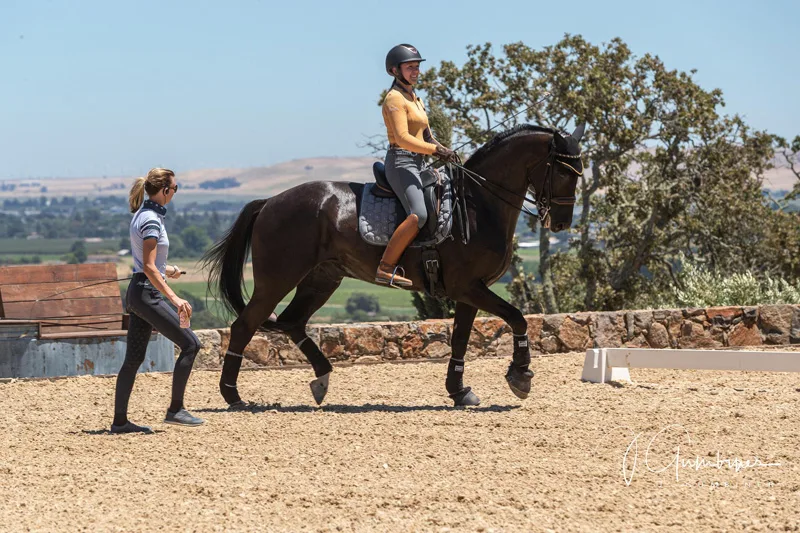On a windy July weekend in Fairfield, California, Iron Rock Dressage welcomed riders and auditors for a two-day clinic with Laura Graves. The view was stunning, but the setting intimate. No grandstand or massive audience. No judges or ribbons, but plenty of nerves to go around.
Walking through the barn the day before, two riders compared plans, discussing matters akin to first day of school jitters.
“Are you going to braid tomorrow?”
“I don’t know! They said we don’t need to but…”
“I know, but I brought my stuff just in case!”
Because of course there’s a certain desire to receive affirmation when you get the opportunity to work with the nation’s top dressage rider. It’s something that Graves, who teaches dozens of these clinics every year, confronted head-on.
“I’m not here to sit back and be wowed by everyone’s beautiful riding,” said Graves. “I’m here to help, and part of that is finding where the problems are and helping you correct them.”
The exhalation of relief was almost audible. No need for nerves; it was time to get down to business.

Laura Graves didn’t want things to go perfectly. She wanted to see what the issues were so she could offer solutions. Hannah Beebe Photo
Hiding Mistakes Fixes Nothing
All coaches are demanding. Most are disciplined. Some are motivational. But very few are as frank, yet as fun, as Laura Graves.
“If you got into a car, turned on the engine, punched the gas, and went nowhere, what would you do?” Graves asked Emily Smith, who was riding her 12-year-old Hanoverian gelding Firmamento (Don Crusador—Rika), a schoolmaster she purchased last year with the goal of representing Region 7 at the 2020 North American Youth Championships.
“Umm…” Smith responded cautiously. She knew where this is going. “Firmy” is as sweet, and as lazy, as they come.
ADVERTISEMENT
“No seriously,” said Graves. “What would you do?”
“I guess I’d bring it to a mechanic,” said Smith.
“No,” said Graves. “Can I tell you what you’d do?”
Now Smith is really confused.
“You, Emily, would get out of that car and push it to wherever you had to go,” said Graves. “Because you, Emily, are a hard worker. And you are the type of person who gets out of the car and sweats instead of stopping to fix it.”
Smith lit up instantly in laughter. So did her trainer, her mother and all of the auditors. Point taken and well-received.
Graves proceeded to help Smith from the ground, encouraging her to stay entirely relaxed and forbidding her from pushing this proverbial car any further.
“You can’t ride so well that you hide all the mistakes,” said Graves. “You have to be really honest and disciplined about what you expect from every aid you give.”

Laura Graves helped Emily Smith get Firmamento more sensitive to the aids. J Gumbiner Photography Photo
The goal of the exercise was for Smith to do nothing but cluck, and for Firmy to trot off. At first, Smith clucked and got no response. Graves cracked the whip behind Firmy, and he let out a little buck and cantered off.
“Pat him!” called Graves, walking briskly to keep up. “You just sit there and don’t fall off.”
Back down to a walk. Another cluck. This time Firmy piaffed. Graves cracked the whip.
“It’s a nice party trick,” she said. “But it’s not what we’re asking for, and it’s still not in front of your leg.”
ADVERTISEMENT
It took a few rounds, but before long Firmy understood the rules of this new game. “Go” was his responsibility, and Smith was back in the driver’s seat.
Don’t Forget The Function
That became a theme for the weekend: Find a problem, boil it down to the basics, set a baseline expectation, and build on it.
Graves repeatedly challenged riders to set the terms of their expectations and stick to them, every transition, every gait. “Do you love it?” she’d ask. “Be honest with yourself.”
This applied not only to the schoolmasters, but also to the youngsters, a few of which were training third level movements like half-passes and flying changes.
“What is the purpose of a half-pass?” asked Graves. Eyes squinted. Shoulders shrugged. Some whispers of… “Collection? Impulsion?”
“Really the purpose is to get from point A to point B,” she said. “And so, if you set out to do a half-pass, but you can’t even reach your destination, you have a problem. Either your line is too steep for your horse’s ability, or you’re missing something as a rider.”
Graves discouraged riders from accepting mediocrity at any point, arguing instead to ride four strides of half-pass for a 10, rather than the entire movement poorly.
“Additional steps and steepness can be added over time,” she said. “But quality should never be sacrificed.”

Laura Graves had clinic participants focus on riding quality movements for a short period of time. Hannah Beebe Photo
“Laura really made me think about what kind of rider I want to be in the long-term,” said Smith. “So that physically I can ride 10 horses a day and still be graceful and quiet.”
Since the clinic, Smith has been holding herself to new standards, making Firmy march during his hand walks, and trot off from a cluck on the longe.
“He knows exactly what he has to do now,” said Emily. “I’m never pushing the car again!”














